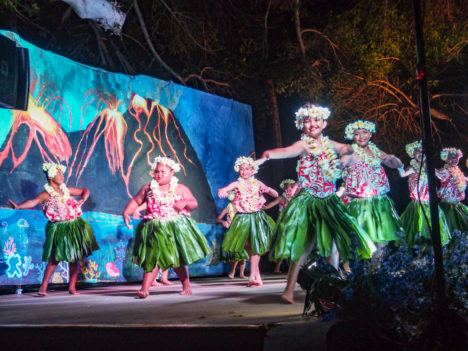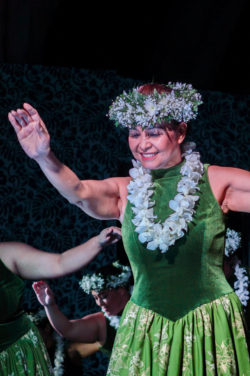Moana’s Hula Halau a Labor of Love
By Catherine Cluett Pactol | Editor

Photo by Catherine Cluett Pactol.
Moana’s Hula Halau held their first show in several years two weeks ago, with standing room only at the Community Health Center. Hundreds of residents and visitors gathered for dinner and the performance under the banyan tree. Nearly 40 Molokai dancers ranging from keiki to kupuna amazed an enthusiastic crowd. They were also joined on stage by a kane group from Maui and a member of sister halau, Moana’s of Japan.
Founded by Moana Dudoit more than 60 years ago, the halau was started by Dudoit after she returned home from college.
“Her first intention was to do it for the family first and she started to teach hula for the family,” said Moana’s sister, Kumu Hula Raquel Dudoit, who has carried on the halau’s legacy following Moana’s death in 2013. “Then everybody saw and they wanted their kids to dance too and then eventually she opened the halau up to more and more people.”
Raquel said she began taking interest in the halau in the early 1980s, eventually becoming a kumu hula and leading the halau with Moana. The halau remains an ‘ohana effort.

Photo by Jack Kiyonaga.
From their travels around Europe, Tahiti and Japan to more than a dozen Merry Monarch festival appearances and many awards, Moana’s has gained acclaim. But for Raquel, unlike many halau in Hawaii, it’s not for the money or the recognition.
“Hula is a job for many people… If you win, you get more money, that’s what the game is all about, it’s a business for them… it’s a competitive world,” she said. “For us it’s like, we have nobody to compete with – if you want to come, come learn. You want to dance, you come dance, you know? I just do it because I think we need hula in our life, I think hula is built in us already.”
Their annual show is a fundraiser for the halau, and Raquel and she teaches free of charge.

Photo by Catherine Cluett Pactol.
This year’s show had a theme of global warming, explained Raquel, to bring awareness to the issue.
“The beaches are getting destroyed, the houses are falling into the ocean, the ocean is rising, I can see it because I live right next to the ocean and it’s coming onto the road…” she said.
Many dancers came home from the mainland to join the halau just for the performance, learning some of the hula just days before the show.
Raquel is proud that her haumana, many of whom she has taught since they were little, continue to dance even if they move from Molokai.
“We try to give them the education of hula because when they travel or go school, they can use it where they go, it’s always with them… It’s something that you can take with you,” she said.
Along with the halau, Raquel and her family run Moana’s Florist shop, Dudoit’s Bus Service for school transportation, a contract to pick up the island’s U.S. Postal Service mail from the airport, a van rental business, and a business that rents inflatable party bounce castles and waterslides.
Raquel admits she’s tired, but she keeps the halau going “for the love of the hula.”
“You always need hula somewhere, because that’s our life, that’s how we learn our history, that’s history talking to us, right? It’s teaching us about the olden days, it’s teaching us about the new days, it teaches us about how to love…” she said.

Photo by Catherine Cluett Pactol.












Don't have a Molokai Dispatch ID?
Sign up is easy. Sign up now
You must login to post a comment.
Lost Password